China # 20 – Mutianyu Great Wall – September 2014
We had seen the Western Terminus of the Great Wall of China back on our China Blog # 8, but being one of the main tourist attractions in the country, we wanted to see more of it. Hey, we drove all this way, why not? We had seen the photos of the hordes of tourists shuffling along the wall like a pack of sardines, so we were expecting the crowds. In 2017 more than 10 million tourists visited the wall, making it one of the world’s most popular tourist attractions.
The Great Wall of China at Mutianyu
It was late afternoon at the Mutianyu Great Wall entrance and the parking lot was nearly empty. All the big tour busses were gone. We found a perfect flat place to park—like anywhere—and a nice soft grassy area right behind us for Green’s tent.
This section of the Great Wall was built in a unique way. There were three watchtowers. Forts were constructed on the steep mountain sides. The northwest part of the wall was precariously constructed along the 3,280-foot, (1,000 m), high mountain ridge. The “Arrow Rock” and “Flying Eagle” sections were built into precipitous cliffs. Legend says that a magic dragon swooped down and marked the route for the wall.
Walking to the entry, we took the gondola to the top and stepped onto the wall, and no one was around. Really!! We had the whole wall to ourselves. There was a little mist in the air, adding to the mysterious and moody presence of this giant man-made piece of architecture. A light jacket would have taken the chill out. We knew the gondola would close before we were finished looking around, but there was a nice flagstone trail back to the parking lot. We wandered along the wall for a couple of hours until it was almost dark. Amazing! (Sorry, that word keeps coming up.)
The “WALL” is 31,070 miles (50,000 km) long. Just for comparison, the Earth’s circumference is 24,901miles, (40,074 km). The wall is 25 feet high in places and 15 to 30 feet wide. It took over 2,000 years to be constructed by several dynasties. Some historical records estimate that it took 300,000–500,000 soldiers to build and guard it, along with another 400,000–500,000 conscripted laborers, convicts, unemployed intellectuals and disgraced noblemen. One report suggests that there were 1.5 million men working during the peak building time of the Qui Dynasty. The Ming dynasty spent 200 years constructing their section of the wall, building paved turreted walls and towers that served as highways to move troops. Although it may be an insignificant thought, all of these men and women had to eat, sleep and go to the bathroom!
It has been estimated that up to one million died working on the wall, and many were buried within the wall itself. (Sounds like Siberia’s infamous “Road of Bones” we drove in 1996.)
During its construction, the Great Wall of China was called “the longest cemetery on earth”. Along the way, the Chinese invented the wheelbarrow. That must have been a big help!
Photographing the wall is challenging. It’s not particularly colorful, and it does not move, but the photos here we hope will give you some impression of its scope as it snakes up and down the ridge tops.
Just for fun, we thought we would look at a comparison of the now infamous Trump’s “big beautiful wall”. It would span only 700 miles of the US-Mexico border’s 2,000 miles. According to sources by Wall Street Journal, it would cost $18 billion to build. Others calculated more like $21 billion. Granted, Trump’s original plan of walls as high as 65 feet have morphed to 18 to 30 feet. Based on the fact that it took six years to build the roughly 700 miles of fence and barriers now in place, engineering experts agree the wall would most likely take years to complete.
All this is complicated by the fact that there are not enough skilled laborers to do the work. Of the 12 sites proposed for the wall, each might require something like 144 employees to feed people, 96 food trucks, 240 private security guards, a hundred legal positions and 5,000 border patrol. Did we count porta potties? As the numbers add up, all 12 projected sites might create 10,500 jobs. Where can they get that many workers? OH!!! How about all the Central Americans who want to come over and work, and while they’re here, they could help rebuild the East Coast that just got devastated by hurricane Florence, and of course, there is a great need of labor in Southern California that slid into the ocean, and the horrible fires of Santa Rosa, Mendocino and Sonoma that are still smoldering. What a great idea! Cheap foreign labor!
Back to the other Great Wall, despite all the money and human cost of building it, and despite efforts to defend it using all the most sophisticated weapons of the time, including axes, sledge hammers, lances, crossbows, halberds and the latest Chinese invention, gun powder, the Mongol invaders led by Genghis Khan, (“universal ruler”), had no problem going around the wall and subsequently conquering most of northern China between A.D. 1211 and 1223 from where they ruled all of China until 1368. Wall? What wall? At least it did provide some protection to the Silk Road we had been following. From the misty towers of the Mutianyu section of the Great Wall, we could almost smell the salt air of the Yellow Sea, the second goal of The Turtle Expedition’s Trans-Eurasian Odyssey; to drive from the wave-torn rocky cliffs of Cabo da Roca in Portugal, the most western point in continental Europe and in fact, the most western point of the Eurasian landmass, all the way to the Pacific, wheels on the ground through 23 countries.
- From the main entrance of the Mutianyu section of the Great Wall a gondola whisked us up about 1000 feet to the wall itself.
- There was a little mist in the air, adding to the mysterious presence of this giant man-made piece of architecture.
- Many consider this the very best place to see the Great Wall with its unique features.
- There were three watchtowers. The northwest part of this wall was constructed along the 1000-meter-high, (3,280 ft), mountain ridge. The “Arrow Rock” and “Flying Eagle” sections were laid on precipitous cliffs.
- We saw only two other couples during the time we spent exploring the wall.
- We could only imagine the hundreds of skilled artists and laborers it took to design and build each section.
- With no one around, we couldn’t resist taking some souvenir shots. Hey, look at us on the Great Wall of China!
- No more gondolas on top. It’s all up and down, following the ridge tops.
- This iron canon could be loaded with 2 kilos, (4.4 lbs.), of explosives. At an angle of 30°, it had a range of 150 m, (429 ft). The noise and smoke would probably scare invaders away.
- The Great Wall architects had more than just defense in their design. Aesthetics were also important.
- I could (almost) smell the salt air of the Pacific Ocean and the Yellow Sea, only a day’s drive away from here, marking the end of the second goal of the Trans-Eurasian Odyssey, but we are not home yet.
- It was almost dark when we descended from the wall to the parking lot on a flagstone walkway.
- The totally abandoned parking lot made one of our quietest camps on the entire expedition across China. Green slept well in her cozy little MSR tent.



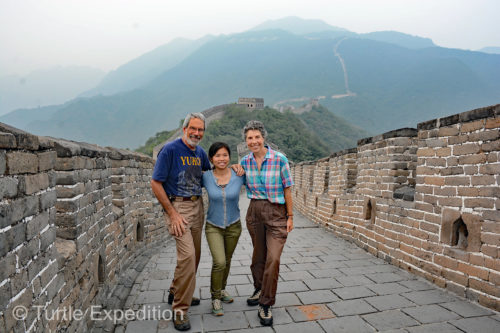
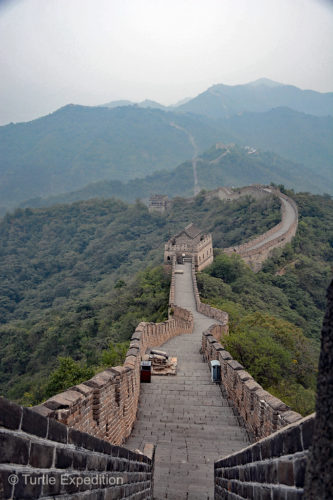
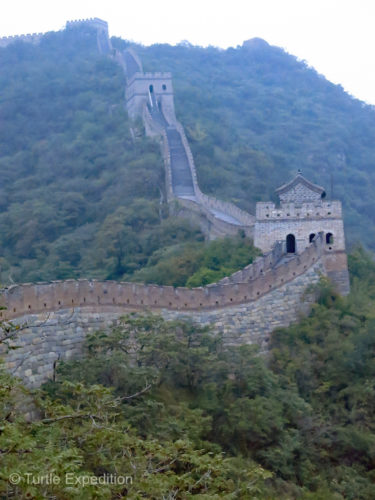
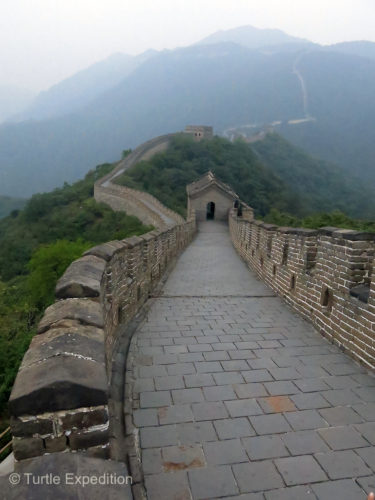
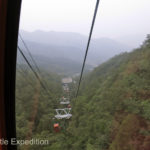
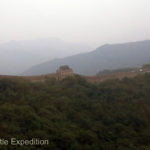
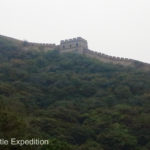
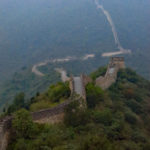
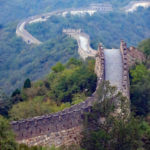
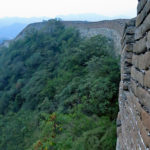
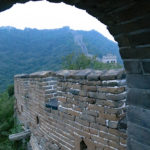
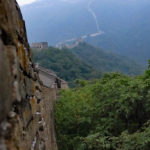
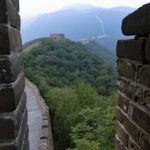
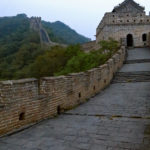
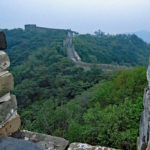
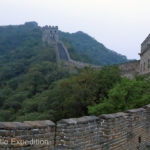
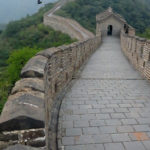
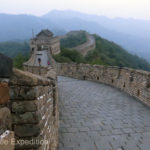
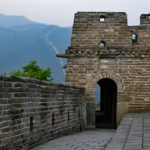
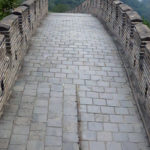
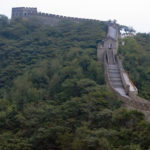
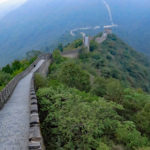
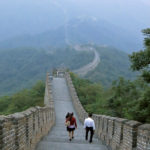
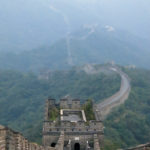
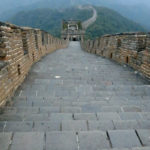
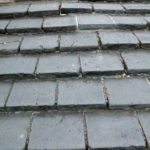

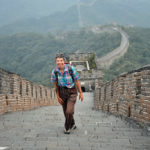
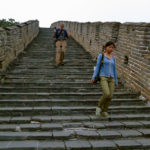
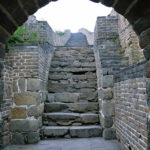
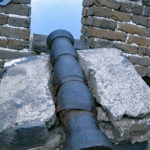
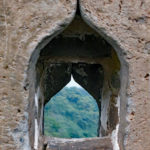
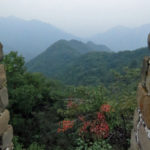
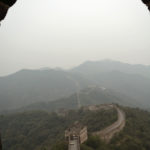

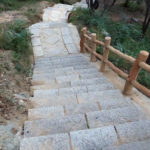
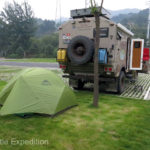








Leave a Comment